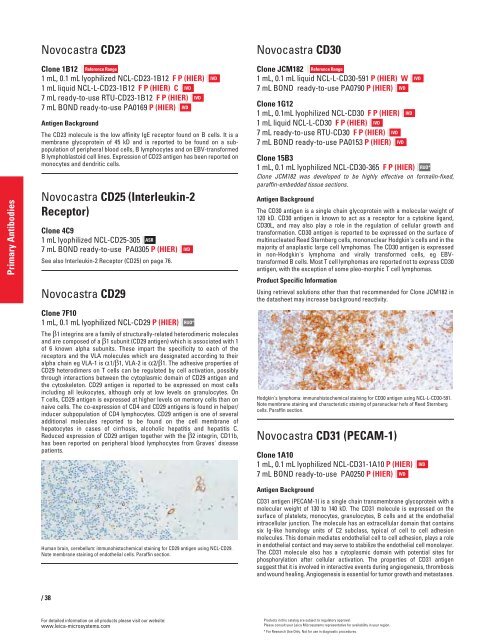QF0159 Marketing Release Record
QF0159 Marketing Release Record
QF0159 Marketing Release Record
You also want an ePaper? Increase the reach of your titles
YUMPU automatically turns print PDFs into web optimized ePapers that Google loves.
Primary Antibodies<br />
Novocastra CD23<br />
Clone 1B12 Reference Range<br />
1 mL, 0.1 mL lyophilized NCL-CD23-1B12 F P (HIER)<br />
1 mL liquid NCL-L-CD23-1B12 F P (HIER) C IVD<br />
7 mL ready-to-use RTU-CD23-1B12 F P (HIER) IVD<br />
7 mL BOND ready-to-use PA0169 P (HIER) IVD<br />
Antigen Background<br />
The CD23 molecule is the low affinity IgE receptor found on B cells. It is a<br />
membrane glycoprotein of 45 kD and is reported to be found on a subpopulation<br />
of peripheral blood cells, B lymphocytes and on EBV-transformed<br />
B lymphoblastoid cell lines. Expression of CD23 antigen has been reported on<br />
monocytes and dendritic cells.<br />
Novocastra CD25 (Interleukin-2<br />
Receptor)<br />
Clone 4C9<br />
1 mL lyophilized NCL-CD25-305 ASR<br />
7 mL BOND ready-to-use PA0305 P (HIER)<br />
See also Interleukin-2 Receptor (CD25) on page 76.<br />
Novocastra CD29<br />
Clone 7F10<br />
1 mL, 0.1 mL lyophilized NCL-CD29 P (HIER)<br />
The �1 integrins are a family of structurally-related heterodimeric molecules<br />
and are composed of a �1 subunit (CD29 antigen) which is associated with 1<br />
of 6 known alpha subunits. These impart the specificity to each of the<br />
receptors and the VLA molecules which are designated according to their<br />
alpha chain eg VLA-1 is �1/�1, VLA-2 is �2/�1. The adhesive properties of<br />
CD29 heterodimers on T cells can be regulated by cell activation, possibly<br />
through interactions between the cytoplasmic domain of CD29 antigen and<br />
the cytoskeleton. CD29 antigen is reported to be expressed on most cells<br />
including all leukocytes, although only at low levels on granulocytes. On<br />
T cells, CD29 antigen is expressed at higher levels on memory cells than on<br />
naive cells. The co-expression of CD4 and CD29 antigens is found in helper/<br />
inducer subpopulation of CD4 lymphocytes. CD29 antigen is one of several<br />
additional molecules reported to be found on the cell membrane of<br />
hepatocytes in cases of cirrhosis, alcoholic hepatitis and hepatitis C.<br />
Reduced expression of CD29 antigen together with the �2 integrin, CD11b,<br />
has been reported on peripheral blood lymphocytes from Graves' disease<br />
patients.<br />
Human brain, cerebellum: immunohistochemical staining for CD29 antigen using NCL-CD29.<br />
Note membrane staining of endothelial cells. Paraffin section.<br />
/38<br />
For detailed information on all products please visit our website:<br />
www.leica-microsystems.com<br />
IVD<br />
RUO*<br />
IVD<br />
Novocastra CD30<br />
Clone JCM182 Reference Range<br />
1 mL, 0.1 mL liquid NCL-L-CD30-591 P (HIER) W<br />
7 mL BOND ready-to-use PA0790 P (HIER) IVD<br />
Clone 1G12<br />
1 mL, 0.1mL lyophilized NCL-CD30 F P (HIER)<br />
1 mL liquid NCL-L-CD30 F P (HIER)<br />
7 mL ready-to-use RTU-CD30 F P (HIER)<br />
7 mL BOND ready-to-use PA0153 P (HIER)<br />
Clone 15B3<br />
1 mL, 0.1 mL lyophilized NCL-CD30-365 F P (HIER) RUO*<br />
Clone JCM182 was developed to be highly effective on formalin-fixed,<br />
paraffin-embedded tissue sections.<br />
Antigen Background<br />
The CD30 antigen is a single chain glycoprotein with a molecular weight of<br />
120 kD. CD30 antigen is known to act as a receptor for a cytokine ligand,<br />
CD30L, and may also play a role in the regulation of cellular growth and<br />
transformation. CD30 antigen is reported to be expressed on the surface of<br />
multinucleated Reed Sternberg cells, mononuclear Hodgkin's cells and in the<br />
majority of anaplastic large cell lymphomas. The CD30 antigen is expressed<br />
in non-Hodgkin's lymphoma and virally transformed cells, eg EBVtransformed<br />
B cells. Most T cell lymphomas are reported not to express CD30<br />
antigen, with the exception of some pleo-morphic T cell lymphomas.<br />
Product Specific Information<br />
Using retrieval solutions other than that recommended for Clone JCM182 in<br />
the datasheet may increase background reactivity.<br />
Hodgkin's lymphoma: immunohistochemical staining for CD30 antigen using NCL-L-CD30-591.<br />
Note membrane staining and characteristic staining of paranuclear hofs of Reed Sternberg<br />
cells. Paraffin section.<br />
Novocastra CD31 (PECAM-1)<br />
Clone 1A10<br />
1 mL, 0.1 mL lyophilized NCL-CD31-1A10 P (HIER)<br />
7 mL BOND ready-to-use PA0250 P (HIER) IVD<br />
Antigen Background<br />
CD31 antigen (PECAM-1) is a single chain transmembrane glycoprotein with a<br />
molecular weight of 130 to 140 kD. The CD31 molecule is expressed on the<br />
surface of platelets, monocytes, granulocytes, B cells and at the endothelial<br />
intracellular junction. The molecule has an extracellular domain that contains<br />
six Ig-like homology units of C2 subclass, typical of cell to cell adhesion<br />
molecules. This domain mediates endothelial cell to cell adhesion, plays a role<br />
in endothelial contact and may serve to stabilize the endothelial cell monolayer.<br />
The CD31 molecule also has a cytoplasmic domain with potential sites for<br />
phosphorylation after cellular activation. The properties of CD31 antigen<br />
suggest that it is involved in interactive events during angiogenesis, thrombosis<br />
and wound healing. Angiogenesis is essential for tumor growth and metastases.<br />
IVD<br />
Products in this catalog are subject to regulatory approval.<br />
Please consult your Leica Microsystems representative for availability in your region.<br />
* For Research Use Only. Not for use in diagnostic procedures.<br />
IVD<br />
IVD<br />
IVD<br />
IVD<br />
IVD
















